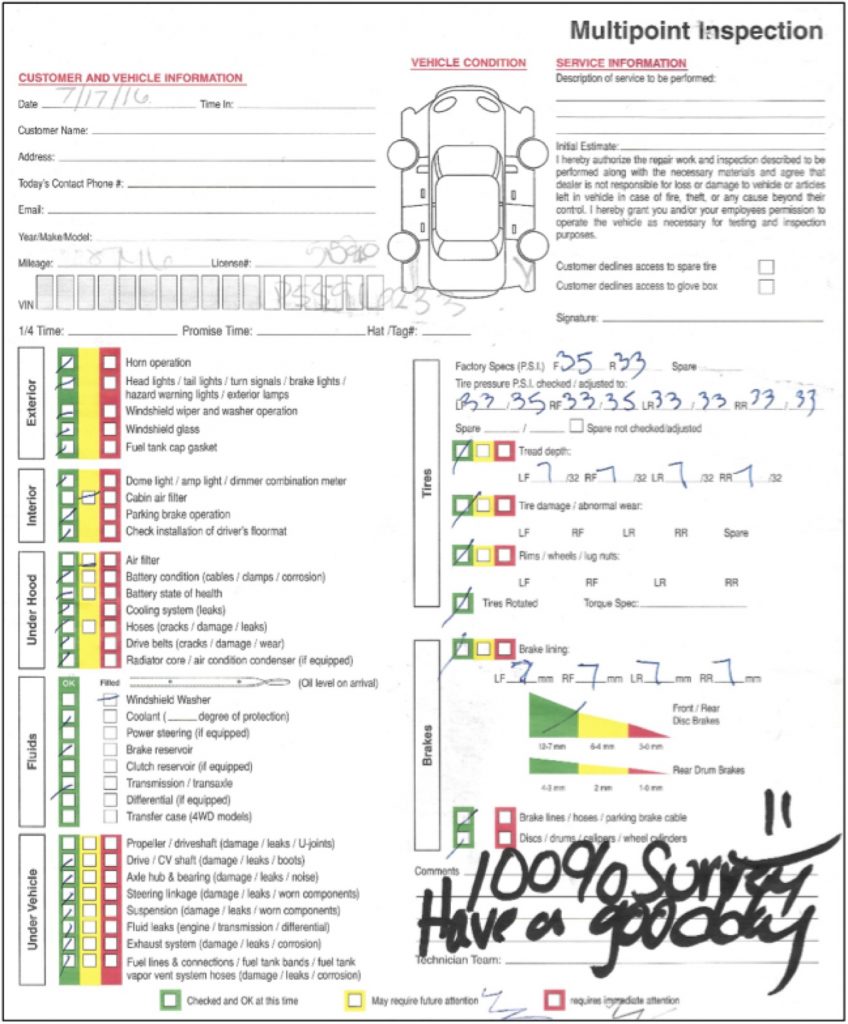The simple answer is – EVERYTHING!
Let me briefly describe my recent car service experience and then you’ll understand why I say this and why an alternative approach to the problem is required.
I dropped off my car for a routine service and stated to the service manager that the headlights on one side of the car were non-functional. After noting my feedback and confirming the details of this technologically advanced hybrid vehicle, we shook hands and said our goodbyes.
As you would expect in this day and age, the automotive technician has a complete checklist of what needs to be done for the car based on the service milestone. He or she connects their computer to the car’s onboard diagnostics (ODB) port and runs a series of tests. Any specific notes from the service manager is read and then the technician systematically goes through the process of checking everything as noted in the Multipoint Inspection checklist. Once the job is complete, the car is assigned back to the service manager for the customer to pick-up.
Here is a scanned copy of the actual Multipoint Inspection checklist I received.

When the service manager handed this checklist to me, I noted everything was checked off GREEN, including my headlights. To be sure I asked, “Are the headlights working now?” “Yes, sir, 100%,” was his response.
Unfortunately, when I received the vehicle the headlights were NOT working. Why?
1. The automotive technician failed to check the headlights and noted that everything was operative. This was clearly an error.

2. The service manager had the opportunity to check the quality of automotive technician’s work. Whether he did or not, the manager passed the car with a 100% rating and suggested I give a great survey (smiley face included).

So what do I believe went wrong here and how does this relate to cycle counting?
- Just like the automotive technician, if a forklift driver is presented with an exception in putting product away, it’s probably easier to complete the task and not deal with the exception.
- Checking the quality of completed tasks maybe done in an ad hoc fashion. Checking the count and location of goods is never all encompassing. In the automotive example, the quality check gave 100%. I often hear perceived inventory accuracy rates of up to 99%. If you have a human checking the quality of tasks executed by a human, it will never be 100% or 99%, for that matter.
In both cases you are depending on a highly trained worker, following a well-structured repetitive set of tasks, flawlessly every time. Even if the person is assisted with technology, or additional quality checks are executed, errors still occur for a variety of reasons. I have personally lost count of the number of times I have seen this in the supply chain. After talking to several warehouse workers and general managers from the largest organizations in the world, what I have observed is artificially inflated accuracy statistics. Why? Because just like the service manager asking for a fantastic survey review, accuracy numbers are directly connected to compensation. Also, service departments are just like warehouse operations, dealing with many parallel tasks and a mountain of work, so it is not surprising that errors do occur.
So there you have it. People are prone to mistakes and errors will occur. This is the reason why I believe that automating the repetitive process of inventory reconciliation with autonomous robots is the only way that large companies will be able to deliver on the promise of inventory accuracy and velocity.
 Matt Yearling is CEO of PINC Solutions. He joined PINC Solutions as chief executive officer in March 2013 and is responsible for the overall strategic and operational management of the company. Matt’s past roles include vice president and general manager of Encryption Products at Symantec Corporation, senior vice president of Global CRM Product Development at Sage Inc., Chief Technology Officer for Embarcadero Systems Corp (a Ports America company). As vice president of Oracle On Demand, Matt played a pivotal role in making it Oracle’s fastest growing line-of-business.
Matt Yearling is CEO of PINC Solutions. He joined PINC Solutions as chief executive officer in March 2013 and is responsible for the overall strategic and operational management of the company. Matt’s past roles include vice president and general manager of Encryption Products at Symantec Corporation, senior vice president of Global CRM Product Development at Sage Inc., Chief Technology Officer for Embarcadero Systems Corp (a Ports America company). As vice president of Oracle On Demand, Matt played a pivotal role in making it Oracle’s fastest growing line-of-business.
What Does a Car Service Have to Do with Cycle Counting?
The simple answer is – EVERYTHING!
Let me briefly describe my recent car service experience and then you’ll understand why I say this and why an alternative approach to the problem is required.
I dropped off my car for a routine service and stated to the service manager that the headlights on one side of the car were non-functional. After noting my feedback and confirming the details of this technologically advanced hybrid vehicle, we shook hands and said our goodbyes.
As you would expect in this day and age, the automotive technician has a complete checklist of what needs to be done for the car based on the service milestone. He or she connects their computer to the car’s onboard diagnostics (ODB) port and runs a series of tests. Any specific notes from the service manager is read and then the technician systematically goes through the process of checking everything as noted in the Multipoint Inspection checklist. Once the job is complete, the car is assigned back to the service manager for the customer to pick-up.
Here is a scanned copy of the actual Multipoint Inspection checklist I received.
When the service manager handed this checklist to me, I noted everything was checked off GREEN, including my headlights. To be sure I asked, “Are the headlights working now?” “Yes, sir, 100%,” was his response.
Unfortunately, when I received the vehicle the headlights were NOT working. Why?
1. The automotive technician failed to check the headlights and noted that everything was operative. This was clearly an error.
2. The service manager had the opportunity to check the quality of automotive technician’s work. Whether he did or not, the manager passed the car with a 100% rating and suggested I give a great survey (smiley face included).
So what do I believe went wrong here and how does this relate to cycle counting?
In both cases you are depending on a highly trained worker, following a well-structured repetitive set of tasks, flawlessly every time. Even if the person is assisted with technology, or additional quality checks are executed, errors still occur for a variety of reasons. I have personally lost count of the number of times I have seen this in the supply chain. After talking to several warehouse workers and general managers from the largest organizations in the world, what I have observed is artificially inflated accuracy statistics. Why? Because just like the service manager asking for a fantastic survey review, accuracy numbers are directly connected to compensation. Also, service departments are just like warehouse operations, dealing with many parallel tasks and a mountain of work, so it is not surprising that errors do occur.
So there you have it. People are prone to mistakes and errors will occur. This is the reason why I believe that automating the repetitive process of inventory reconciliation with autonomous robots is the only way that large companies will be able to deliver on the promise of inventory accuracy and velocity.
TAGS
Subscribe to Our YouTube Channel
TOPICS
Categories
Subscribe to Our Podcast
TRENDING POSTS
Sponsors